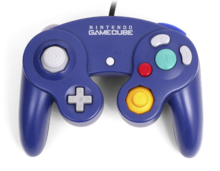 Indigo GameCube controller | |
| Manufacturer | Nintendo |
|---|---|
| Product family | GameCube |
| Type | Gamepad |
| Generation | Sixth |
| Release date | September 14, 2001
|
| Lifespan | 2001–present |
| Input |
|
| Connectivity | GameCube controller port |
| Dimensions |
|
| Predecessor | Nintendo 64 controller |
| Successor | |
The GameCube controller is the standard game controller for the GameCube home video game console, manufactured by Nintendo and launched in 2001. As the successor to the Nintendo 64 controller, it is the progression of Nintendo's controller design in numerous ways. The contentious M-shaped design of its predecessor was replaced with a more conventional handlebar style controller shape; a second analog stick was added, replacing the C buttons with a C stick and the X and Y face buttons, last seen on the Super Nintendo controller, were reintroduced; the shoulder buttons were changed to hybrid analog triggers. A wireless variant of the GameCube controller known as the WaveBird was released in 2002.
Though many elements of the GameCube controller's unique design were not embraced by many future twin-stick gamepads (such as the pressure-sensitive shoulder buttons and a face button layout that emphasizes one button over three others), some controllers adopted its staggered analog stick layout. The GameCube controller continued to endure even beyond its system's launch cycle, gaining varying levels of support from its subsequent successor consoles.
Years after the GameCube's discontinuation, Nintendo officially re-released the controller, with the international launch of the fourth and fifth installments of the Super Smash Bros. series, Super Smash Bros. for Wii U and Super Smash Bros. Ultimate, due to the persisting popularity of the GameCube controller in the Super Smash Bros. community after the release of the critically-acclaimed Super Smash Bros. Melee in 2001.